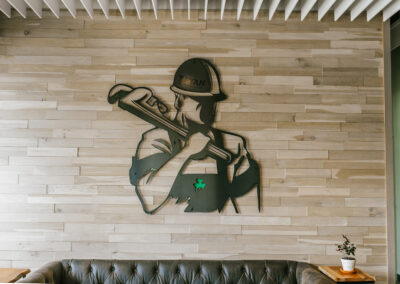A functioning sprinkler system is important for any building, but is exceptionally important in health care operations and senior living facilities because they can be more difficult to evacuate in the event of a fire.
Because rust requires water and oxygen in order to form, a sprinkler system can create a perfect growing environment for rust. Over time, rust builds up in a sprinkler system and the piping begins to corrode from the inside out. Corrosion will also create debris that can clog the pipe and sprinkler heads.
Preventative maintenance is key. Scheduling and performing regular inspections will help ensure the sprinkler system will function correctly if the need arises.
An internal inspection, the standard 5-year inspection, will indicate if your building’s sprinkler system potentially needs a flushing. “Even a half cup of debris can be enough to clog a sprinkler head and prevent it from working correctly, making it extremely important to stay proactive with maintenance,” said Nick O’Gara, service project manager at Ryan Fireprotection.
Even just having basic knowledge about your sprinkler system, including where the valves and air compressor are located and how they should function, can decrease the hassle if a problematic situation arises.
Additionally, the NFPA requires a visual inspection of all areas annually. As a facility manager or building owner performing an inspection in house, Ryan Fireprotection recommends looking for corroded piping, system leaks or a continuously running air compressor. To ensure this inspection is thorough, we recommend scheduling an appointment with a Ryan Fireprotection professional.
In the event a sprinkler system is experiencing issues with corrosion, the sprinkler system will likely need to be flushed to clean out any debris that is lingering in the pipe or at the sprinkler heads. “Generally, once your sprinkler system has corrosion issues and needs to be flushed, the corrosion will continue to grow and will need to be inspected internally on a more frequent basis,” O’Gara added.
Flushing Your Sprinkler System
Performing inspections and flushing sprinkler systems are often lower cost expenses when compared to the cost of replacing damaged systems or dealing with the aftermath of a non-functioning sprinkler system. Flushing the sprinkler system will clean the system of debris and the gradual build up of foreign materials that are associated with corrosion. As corrosion continues to build and becomes a more frequent issue, requiring more inspections and flushes, nitrogen may be a better option for your system.
Nitrogen As A Solution
The best time to incorporate nitrogen into a sprinkler system is immediately following a system flush. The installation process typically takes a few days and requires an additional investment to install but saves money on costly repairs. Nitrogen takes the place of the oxygen in the sprinkler system and prevents corrosion from getting worse. To learn more about using nitrogen in your building’s sprinkler system, contact Ryan Fireprotection today.
